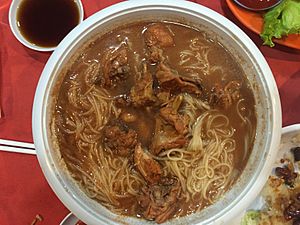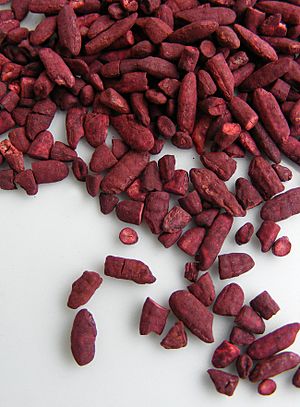Red yeast rice facts for kids
Red yeast rice is a special type of rice that gets its bright reddish-purple color from being grown with a mold called Monascus purpureus. It's also known by other names like red rice koji, red fermented rice, or angkak.
In Japanese, "koji" means a grain or bean that has been grown with a mold. This way of preparing food has been around since about 300 BC. In English, when people talk about its Japanese uses, they often call it "red rice koji." If they are talking about its Chinese uses, they usually say "red yeast rice."
Besides being used in cooking, red yeast rice has also been used in Chinese herbology and Traditional Chinese medicine. People believe it was first used this way around the year AD 800 during the Tang Dynasty. The famous Chinese book on medicines, Ben Cao Gang Mu by Li Shizhen, describes red yeast rice.
In the late 1970s, scientists found that red yeast rice contains natural substances called monacolins. One of these, monacolin K, is the same as a medicine called lovastatin, which is used to lower cholesterol. Because of this, red yeast rice became popular as a dietary supplement. However, in 1998, the U.S. Food and Drug Administration (FDA) tried to stop some red yeast rice supplements from being sold. They said that products with monacolin K were too much like a prescription drug and should be regulated as medicines.
Contents
How is Red Yeast Rice Made?
Red yeast rice is made by growing the mold Monascus purpureus on regular rice. This process usually takes about 3 to 6 days at room temperature. During this time, the rice grains turn bright red inside and reddish-purple on the outside.
Once the rice is fully cultured, it can be sold in different ways. It might be sold as dried grains, or cooked and made into a wet paste. It can also be dried and ground into a fine powder. China is the biggest producer of red yeast rice in the world, but companies in Europe also make it now.
What is Red Yeast Rice Used For?
Red yeast rice has been used for hundreds of years in different ways, especially in food and traditional medicine.
Using Red Yeast Rice in Cooking

Red yeast rice is used to add a reddish color to many foods. You can find it in things like pickled tofu, red rice vinegar, char siu (Chinese BBQ pork), Peking duck, and some Chinese pastries.
In China, people have used red yeast rice in cooking since at least the first century AD. It's also traditionally used to make certain Chinese wines called huangjiu (like Shaoxing jiu) and Japanese sake (called akaisake). It gives these wines a reddish color.
The leftover bits from making wine, called hóngzāo, can be used as a flavoring. They give food a mild but pleasant taste. Hóngzāo is very popular in Fujian cuisine, a type of Chinese cooking. It's used in dishes like Fujian red wine chicken, which is a special meal for birthdays and Chinese New Year.
In the Philippines, red yeast rice (called angkak) is also widely used. It helps color and preserve traditional foods like fermented shrimp (bagoong alamang), burong isda (fermented rice and fish), and balao-balao (fermented rice and shrimp).
Red Yeast Rice in Traditional Medicine
Besides its use in cooking, red yeast rice is also part of Chinese herbology and traditional Chinese medicine. The Chinese medicine book Ben Cao Gang Mu, written around 1590 by Li Shizhen, talks about its medicinal uses.
Traditionally, it was suggested to be taken to make the body stronger, help with digestion, and improve blood circulation. One old saying about it was that it helps "promote the circulation of blood and release stasis, invigorating the spleen and eliminating [in]digestion."
See also
 In Spanish: Arroz de levadura roja para niños
In Spanish: Arroz de levadura roja para niños


